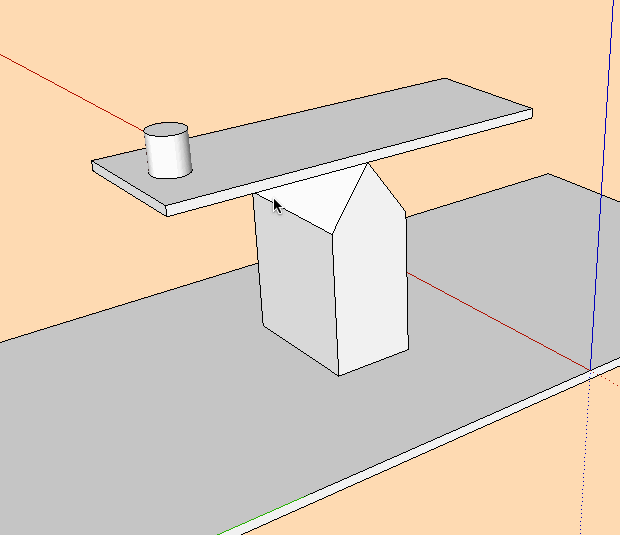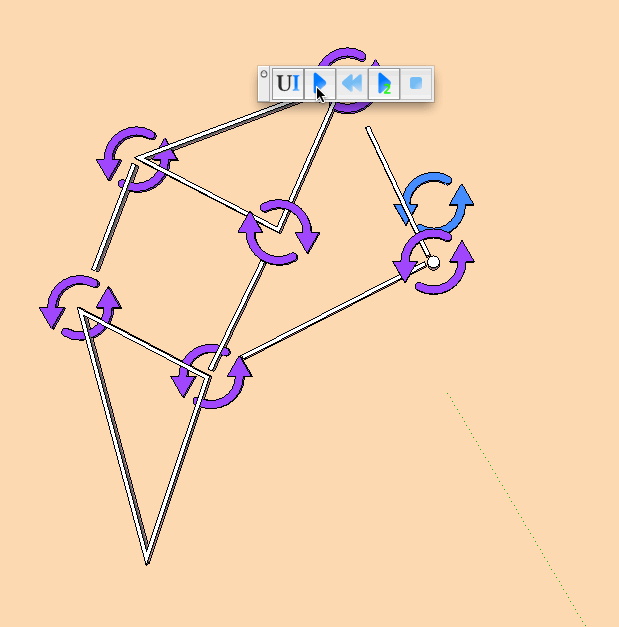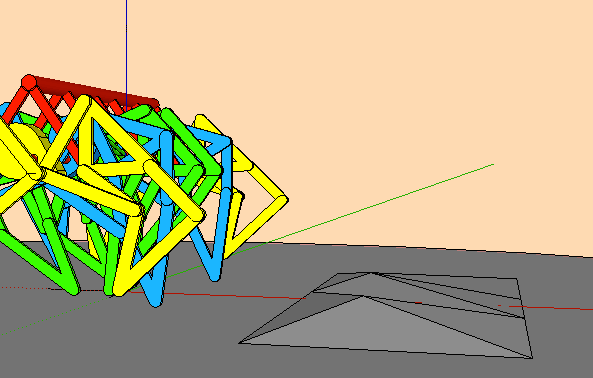MSPhysics 1.0.3 (16 October 2017)
-
Hi Anton
Congrats on your great work resurecting old SP for a new version. I played with SP some years ago and amazed myself by getting a caterpillar track chain to workMay I ask if it is possible, in your version, to assign real physical values to objects, eg mass in kg, spring rate m/kg, damping kg/m^2 and so on
and perhaps equivalent elements for rotating masses
Its all in aid of helping my student understand the dynamic behaviour of physical systems with different input and load conditions open loop and closed loop
If this could be done, it would be of fantastic benefit for Uni ugrads (yes there are professional - expensive suites to do this). Something tailored to fit with the unbeatable SU would be so good
It wasn't available in the original SP, only cruded dimensionless tweaks
Cheers
Robin
ps apologies if this has already been answered pls link me
-
Hi, robint,
Just to clarify a thing, MSPhysics is not a new version of SketchyPhysics; MSPhysics is a plugin written completely from scratch, integrating the latest NewtonDynamics Physics engine by Julio Jerez. Yes, it does have a similar functionality to SketchyPhysics, but that was done because I didn't want to reinvent all the ideas Chris Phillips put into writing SketchyPhysics and so that SketchyPhysics users wouldn't have hard time transitioning to MSPhysics.
In MSPhysics, the mass (kg), force (N), torque (Nm), angular velocity (rad/s), and linear velocity (m/s) - are controled with the standard SI units. These values are proper, even with the world scale set to some value other than one, as behind the scenes they are scaled to maintain themselves in SI units. The parameters for joints, such as power, accel, damp, and friction, however, are controlleded with unknown units. While writing the custom joints, I didn't place close attension to the units, but I think they can be converted to the units you described in your post. Some testing needs to be done to figure out the ratios.
By default the mass is calculated by taking the volume of an object, in m^3, and multiplying it by the density, in kg/m^3, which is by default 700 kg/m^3, the density of wood.
To assign a particular mass to a body, in killograms, you can do it with the UI dialog:
- Select the desired body.
- Open the MSPhysics UI.
- Activate the Body Properties tab.
- Select weight control option and switch it to mass.
- Write the desired mass into the mass input box.
The static and kinetic friciton coeffiences, which can also be assigned through the dialog, are not the actual coefficients. The actual coefficient is an average coeffiecent between the two touching bodies. For instance, if the floor has a static coefficient of 0.9 and kinetic of 0.7, and the touching body has a static coefficient of 0.4 and kinetic of 0.3, the actual static coefficient for the contact, would be (0.9+0.4)/2 and the actual kinetic coefficient would be (0.7+0.3)/2.
The same concept applies to elasticity and softness. I'm no expert what the softness does, as I didn't write the physics engine, doing most of the calculations for my wrapper, but I think it controls how much energy is transfered durding collision, i.e an aditional parameter for elasticity.
To control other physical properties, such as velocity, you need to assign a Ruby script to a group. This can be done by selecting a desired group, activating the Script tab in the MSPhysics UI, and writting some code in the editor. Here's a script for applying a particular velocity to an object whenever simulation starts:
onStart { this.set_velocity(0,1,2) # x, y, z - the velocity vector }The velocity can also be applied every time the world is updated:
onUpdate { this.set_velocity(4,5,6) # x, y, z - the velocity vector }And the velocity can also be recorded:
onUpdate { # Get current velocity cv = this.get_velocity # Output it in the note note = sprintf("Velocity; (%.3f, %.3f, %.3f)", cv.x, cv.y, cv.z) simulation.display_note(note) }You may also apply force, torque, omega, and do other things with scripting. Check out this scripting documentation link:
http://www.rubydoc.info/github/AntonSynytsia/MSPhysics/indexHere is the exact link for all the functions available for a body:
http://www.rubydoc.info/github/AntonSynytsia/MSPhysics/MSPhysics/BodyRegards,
Anton -
Thank you so much Anton, thats given me some homework!
BTW I didn't wish to imply you were overwriting the previous SP. MSP is of course entirely yours started from scratch - brilliant stuff
I'll be glad to pass any useful models I can generate back to you to pass around to other interested parties and perhaps help generate other instructional models
Cheers
Robin
-
Hi, Robin,
I'm glad I could help.
Best regards,
Anton -
Dear Anton,
I just downloaded the plugin to make a simple cinematic / collision check on a folding workbench model, that is basically a deformable parallelogram.
Although I got the basic principle and manage to make singles hinges move as expected, any component is stuck as soon as it's linked to two hinges.There's also a message reading "Requires MSPhysics 0.9.8+" in a corner of the screen, should I understand that it won't work unless I install something else ?
Thanks
Armand -
Hi, Armand,
A hinge with no parent groups will act stationary. In order for the hinge to move, it must have a parent group. What I think is going on in your model is that the hinges are top level groups. If you want a hinge to link two groups together, and still move, simply create a hinge joint within one of the groups andd then, using the joint connection tool, connect it to the other group. That way the hinge joint will have a parent body, which will allow it to move.
Check out this mini clip:
Movable Joints ExampleThe message is there so that people using your model would know that they need MSPhysics in order to run it.
Regards,
Anton -
I think I have some issue with hinge when I link it to a parent:
Mac OSX 10.8.5, SU2015.

-
Hi, gilles,
To fix that, you have to select the joint, open MSPhysics UI, and check the "connected collide" option.
Regards,
Anton -
@anton_s said:
Hi, Robin,
I'm glad I could help.
Best regards,
AntonI made a simple mass/spring damper system as per model, but I get some odd results not like the damped sinusoid
Am I on the right track or have I made some basic errors
Also the block doesn't sit still on the plane but wanders off
I am also having difficulty tying in the UI with real values of spring rate N/m and damping c*velocity Ns/m
Any advice, most appreciated
Cheers
RobinBTW I looked at the Ruby docs but couldnt tie up real units to the constants
-
@anton_s said:
Hi, gilles,
To fix that, you have to select the joint, open MSPhysics UI, and check the "connected collide" option.
Regards,
AntonWorks fine

A lot to dig in, I go back to the mine.
-
Hi, Robin,
The block doesn't sit still probably because you disabled the friction. Enabling the friction checkbox option for the block and for the floor contacting the block will fix the wandering off behavior.
I will add an option to control accel and damp with the SI units in the upcoming release. At the moment, I figured that spring constant is roughly equals to (accel * 7 - damp), when spring joint stiffness is set to 1.0.
Edit: Ensure that both anuglar and linear damping for all bodies are set to zero. This improves the closeness.
Anton
-
Hi Anton
I'm sure I tried every way with the friction coeffs, and it didnt seem to help much, unless Im doing something wrong. If you could get real SI units into the spring damper model this would be fantastic. Classic maths leaves everything in normalised units which is really hard for students to translate into the real world - thats what MS physics is about. I try to encourage my student to abandon th suck-it-and-see approach in favour of understanding what is really happening and calculating the effect. I know that math is a real turn off for most users, but I try
cheers Robin
-
@anton_s said:
Hi, Robin,
The block doesn't sit still probably because you disabled the friction. Enabling the friction checkbox option for the block and for the floor contacting the block will fix the wandering off behavior.
I will add an option to control accel and damp with the SI units in the upcoming release. At the moment, I figured that spring constant is roughly equals to (accel * 7 - damp), when spring joint stiffness is set to 1.0.
Edit: Ensure that both anuglar and linear damping for all bodies are set to zero. This improves the closeness.
Anton
Yes indeed, improved action, I missed the friction box
Herewith a revised model changing block mass from 0 - 0.5 kg gives a displacement of 0 - 1.0 so the spring rate is 2
spring stiff 1 (what does this do?)
Accel 1, damp 1.5 (gives critical damping approx)changing sample rate from 1/60 to 1/240 changes the whole model performance
iterations 16 - improves stability
the plane has a mass of 0.01kg, lowest i could get without instability
So Ive actually got a spring damper that sort of behaves but it seems like the spring has inertial mass - an ideal spring should be zero mass and friction
What do you think? Anything I can do to help (ruby dummy just now)
Cheers
Robin)

-
Hi, Robin,
I just revised the spring joint to base on Hooke's law. Just need to adress a few other things before its ready for the release.
Regards,
Anton -
@anton_s said:
Hi, Robin,
I just revised the spring joint to base on Hooke's law. Just need to adress a few other things before its ready for the release.
Regards,
AntonHi Anton
It occured to me loking at the motor joint, that it would be neat to have control sliders on important coeffs, of spring rate, friction, and damping, help to speed up student experience
BTW just seen some example in Sketchucation, blown away with the talent out there
Hope my little exercises aren' t too dull
Cheers
Robin
-
-
Hi, gilles,
You just need to adjust motor joint properties. So, select the motor joint, open MSPhysics UI, and set Accel to 20, Damp to 10, and uncheck the Free Rotate checkbox option. This should make the motor more stronger.
Anton
-
-
Very clever, gilles!
I'm sure there is a way to improve performance and stiffness of that thing.
Anton
-
Théo Jansen.
Advertisement









